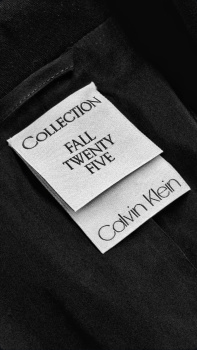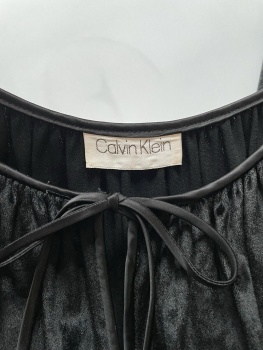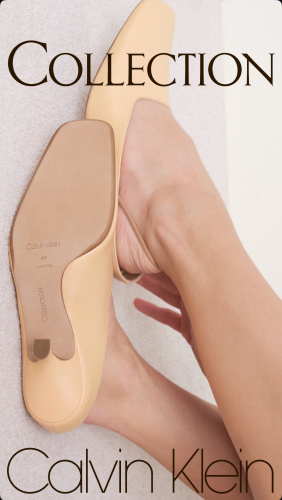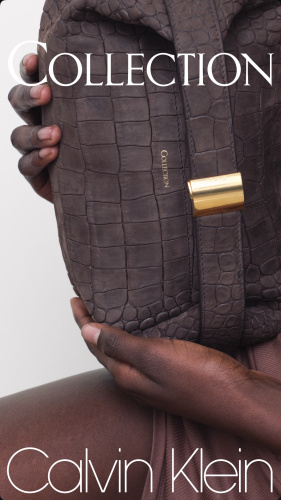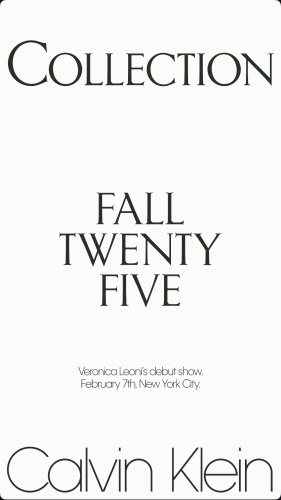Can Calvin Klein Reinvent ‘Sexy’?
As the brand returns to New York Fashion Week, an inside look at what its new designer, Veronica Leoni, has planned.
By Vanessa Friedman
Feb. 6, 2025
Veronica Leoni, the new creative director of Calvin Klein Collection, has been thinking a lot about sex recently. Or not sex, exactly, but the attitude of being comfortable with sex, and your own sexuality. What she calls “sexitude.”
A few weeks before her debut show, which happens to be the most anticipated show of New York Fashion Week, she was standing at a table in the Calvin Klein archive in Long Island City, on the south end of Queens, talking about sexitude. The archive, a 5,000-plus-square-foot storage unit, contains nearly every Calvin Klein runway garment ever created from the first show until now, as well as such relics as Mr. Klein’s 1996 Barbie doll and his original Rolodex, complete with notes on his famous clients and what discount they each received (Bianca Jagger, no charge; Meg Ryan, 25 percent off wholesale), as well as all of the outtakes of his old ad campaigns.
She was flipping through some photos from the first CK One ad campaign, shot by Steven Meisel in 1994 — the one with a gang of disaffected girls and boys, including Stella Tennant, Jenny Shimizu and Kate Moss, in various states of grungy undress: topless, dropping trou, otherwise exposed. The images, Ms. Leoni said, had sexitude. So did a slithery slip dress from around the same era, hanging on a rack nearby.
That was the era when Calvin Klein, which Mr. Klein had founded in 1968, turned into a global juggernaut, built on the foundation of a hedonistic minimalism. His clothes were stripped down, because, they suggested, that made it easier to strip down. No one else was as good at turning sportswear into provocation. Jeans and underwear may have been the popular extensions of that idea, the pulse-raising ad campaigns its overt expression, but neither offered anything near as subtle a come-on as the clothes. It made a seat at his show … well, the hottest ticket in New York.
It’s that sexitude, as far as Ms. Leoni is concerned, that has been missing from the New York runaways for a while now. And not just because Calvin Klein has been missing from the New York runways for over six years, when Raf Simons, the last creative director, was fired and the company announced it was abandoning the high-end collection to focus on jeans and influencers.
Rather, it’s missing because ever since 2002, when Mr. Klein sold his company to PVH and retired, the sense of unapologetic hunger that suffused his provocative ad campaigns as thoroughly as it did a tailored coat, had faded away. The designers who designed for the brand after him focused on a more minimalist elegance (Francisco Costa and Italo Zucchelli, 2004 until 2016) and a dark mirror take on the American dream (Mr. Simons). The lust was left to the infamous traffic-stopping underwear billboards.
Ms. Leoni, who will be the first woman to lead Calvin Klein, wants to see that sense of libido in a sensuous pair of trousers or a pencil skirt. To do that, she wants to take it back to the source. To “glue myself to Calvin’s last day of work,” she said, but then to “flip the perspective.”
“Most of the time, we see women as objects of desire,” she said. “But what if they become the people who desire?”
Riding on her ability to answer that question is both the future of Calvin Klein, a $4 billion brand that once helped define American fashion, and, in some ways, the future of New York fashion (or at least New York Fashion Week).
Originally anchored by the big brands of the 1980s that took American fashion global — Calvin, Ralph, Donna — New York Fashion Week has struggled in recent years as those brands dropped off the official calendar and went their own way or shuttered entirely. Promising new generations of designers have yet to achieve the mass success of those mega-brands. Calvin Klein is a powerful enough name (with editors, retailers, influencers, celebrities) and a big enough company to change all of that. If it has a hit collection.
“It could be a magnet for the eyeballs of the world,” said Steven Kolb, the chief executive of the Council of Fashion Designers of America, which administers New York Fashion Week. “I hope it works.”
Growing Up Calvin
Ms. Leoni, who is Italian, 41, about 5-foot-4 and looks like a sprite with a penchant for rockabilly on her way to an architecture convention, was not the obvious choice to be the new mastermind of Calvin Klein.
Though she had stints at Jil Sander (under Jil Sander), Celine (under Phoebe Philo), Moncler and the Row; started her own brand, Quira, in 2021; and was a finalist for the LVMH Prize in 2023, she had never run a major international house. Outside the fashion world, she is relatively unknown. And though she had impeccable minimalist credentials, she hadn’t exactly demonstrated a fluency with the racier side of dress.
“It was my biggest reservation,” said Karen Harvey, the founder of a namesake consulting firm and the headhunter who had recommended Ms. Leoni for the job. “Could she bring that sexuality? Because we couldn’t leave that out. And I came to think she would actually reinvent it. So she was a risk, but Calvin was known for being bold.”
Ms. Leoni understood the hesitation. “A European project would have been a more obvious match,” she said, “but this is more twisted.” She likes twisted. Besides, she is a child of the 1990s, which means she identifies as a child of Calvin Klein.
“In a sense, Calvin was always with me,” she said. “I’m the CK One generation.” As a girl, she said, “I really felt that Calvin Klein, especially from the European point of view, was this major fantasy of a faraway world where everybody was cool and, you know, so Calvin.”
Ms. Leoni grew up in Rome. Her parents had a coffee shop that her grandparents founded, on the outskirts of the city. Her younger brother is a butcher. It was her grandmother Quirina who taught her to sew and crochet. (Ms. Leoni named Quira in her honor.)
Ms. Leoni always thought she would be a designer, even though she studied literature rather than attending traditional fashion or art school. She learned the trade by interning for a family-run fashion brand in Le Marche, Italy. After she graduated, she talked her way into Jil Sander.
“I remember her studio in Umbria, where everything was white — no chairs, we needed to stand,” Ms. Leoni said. “I really feel that she taught me design, honestly.”
It was her stint at Celine with Ms. Philo, however, that taught Ms. Leoni that a designer could become the personification of a brand. She was there at the same time as Matthieu Blazy (the incoming creative director of Chanel), Daniel Lee (now creative director at Burberry) and Peter Do (the designer of his own label in New York). They worked like “crazy,” she said, but none of them minded because they were so committed to Ms. Philo. They are all still friends.
Mr. Blazy was, coincidentally, at Calvin Klein when Mr. Simons was in charge, but Ms. Leoni said they had not discussed the brand. He did, however, recommend his favorite Smashburger place in New York.
In 2023, Ms. Leoni married Sara Casani, a film casting director. They have been together 12 years. When she is home Ms. Leoni describes herself as “a first lady.” She is commuting between Rome and New York, hotel-surfing her way through Manhattan, though she hopes to get a pied-à-terre in the city.
Even though Calvin Klein’s management has somewhat hedged its bets — Ms. Leoni is in charge only of Collection, the high-end, runway part of the business, rather than the Jeremy Allen White jeans part of the business — and even though she has to produce only two collections a year, for spring and fall, she is beginning to feel the pressure. The idea, said Eva Serrano, the global brand president of Calvin Klein, is to have Ms. Leoni’s work trickle down to set the pace and direction for everything else.
“The chance to have my vision of life on such a huge platform is actually thrilling,” Ms. Leoni said. “I want to own the black turtleneck business.”
A Litany of Desire
When Ms. Leoni arrived at the Calvin Klein headquarters in New York’s garment district for the first time last fall, Frankie Perdomo, the doorman who has worked in the building since 1997, greeted her with a hug. “You’re here!” she recalled him crowing, just before he bestowed upon her the honor of her own elevator. He does it every time she enters the building.
“It’s always so embarrassing,” she said, somewhat ruefully. She is not a demand-her-own-elevator kind of person.
She works in a tiny office on the ninth floor next to the studio, which is full of mood boards with David Byrne and Gwyneth Paltrow and Brad Pitt in the ’90s, when the latter were a couple and Ms. Paltrow was wearing a lot of Calvin. (Mr. Klein’s original office is preserved one floor up.)
The studio is in turn next to the workroom, which is full of patternmakers and seamstresses. Though it is a lot smaller than it was in the early years — five sewers and three patternmakers instead of the high of 50 and 30 — there are still employees who have been there since the Calvin days.
Hardeo Samaroo, a tailor, is one of them; he joined the company in 1996. Ms. Leoni, he said, “is obsessed with details. She checks everything. It’s the same as what Calvin was doing.”
It feels, he said, as if “the brand we had in the ’90s is coming back to us.”
Still, other than a shoe design from 1999 — a square-toe silk ballerina flat with the tiniest elastic sling-back strap — that Ms. Leoni has reproduced almost exactly for her debut, there is very little that is overtly taken from the past. It’s more of a mood. She said she is in search of the kind of “monumental minimalism” Calvin Klein had at the end of the last century.
(She has been in touch with Mr. Klein, who lives in California, via letter, and has been in contact with his former wife, Kelly.)
Ms. Leoni is trying to ignore the expectations. “I feel people are just putting together the pieces of my C.V. to predict the first outfit in my show, almost like an A.I. situation,” she said with an implicit eye roll. “But I am really trying to surprise myself. It would be too easy to just do tailoring. Sex is maybe a little bit less predictable.”
She will show both men’s and women’s wear, but the collection is not unisex. “I really feel that unisex is just sloppy fitting,” she said. “Bodies are different.” It also does not involve street style or oversize silhouettes.
“It’s very scary to strip back,” she said, “because the king is naked when it’s just about clothes. You really have to have confidence to let people hear the noise of the fabric when they walk, and see the inside of a jacket.” But it also creates the sense of intimacy she wants, the bit of implicit peekaboo. Corsets and push-ups and (ahem) visible packages are not the only things that suggest physical hunger.
“It is more about finding a certain posture, a certain body attitude,” Ms. Leoni said. “There are no shoulder pads. Sometimes tailoring shapes the body, but I wanted the body to shape the tailoring.” She is comfortable expressing her wants.
She wanted, for example, clothes that seemed easy for anyone to shrug on and off. Like a pencil skirt with no side seams, so it can be wiggled into; a sheer spaghetti-strap top with straps that are mere filaments, so it almost seems suspended on the torso. She wanted material that felt good sliding around on the skin, like “silk that is smooth and super peachy.”
Above all, she said, she wanted “Calvin to be the magnet the conversation revolves around.
I want it to become an adjective,” she said. “‘It’s very Calvin.’ That’s the goal.”

